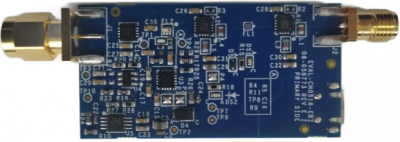
The EVAL-CN0518-EBZ is a USB-powered, RF power amplifier that is optimized for receiving signal chains in the 915 MHz ISM band. Using two HMC376 amplifiers cascaded together, the design provides a gain of 25 dB and return losses of more than 10 dB at its center frequency.
The circuit includes a high speed overpower cutoff that protects sensitive downstream equipment connected to the receiver system. The receiver system also automatically returns to normal operation when the RF power level drops within the acceptable range.
Designed to be used with the ADALM-PLUTO, the EVAL-CN0518-EBZ features a small form factor with dimensions of 25.4 mm × 49.6 mm x 1.5748 mm (PCB only). The RF input and output are designed with a 50 Ω impedance, enabling direct connection between the circuit and standard 50 Ω systems.
A micro-USB connector is used for the input power, allowing the evaluation board to use most +5 V wall wart power supplies available in the market.
 Figure 1. EVAL-CN0518-EBZ Reference Design Board
Figure 1. EVAL-CN0518-EBZ Reference Design Board
The EVAL-CN0518-EBZ features the HMC376, which is a GaAs, pHEMT, MMIC, low noise amplifier operating between 700 MHz to 1000 MHz. This amplifier is ideal for use in GSM and CDMA cellular base station front end receivers. This low noise noise amplifier does not require any external matching circuitry to operate.
The SMA connectors are used for the RF input and output connections.
| RF Port | Reference Designator | Description |
|---|---|---|
| RF Input (SMA male connector) | J2 | Connect to a radio or piece of RF equipment |
| RF Output (SMA female connector) | J1 | Connect to an antenna |
The reference design uses two LEDs to indicate its current status:
| RF Port | Reference Designator | Description |
|---|---|---|
| Green LED | (DS1) | Indicates that power is present on the board |
| Red LED | (DS2) | Indicates when an overpower event occurs |
This table shows the board status when the various LEDs are ON/OFF.
| Green LED | Red LED | Board Status |
|---|---|---|
| OFF | OFF | No Power |
| ON | Off | Normal RF Operation |
| ON | ON | Overpower Event (RF Output Attenuated) |
For the step-by-step procedure on how to update the Pluto Firmware, you can use this user guide link.
The latest firmware version for the ADALM-PLUTO can be found here:
ADALM-PLUTO Firmware
Follow the step-by-step process on how to configure the ADALM-PLUTO for proper operation by referring to this link.
 Figure 11. EVAL-CN0518-EBZ Test Setup
Figure 11. EVAL-CN0518-EBZ Test Setup
 Figure 12. IIO Oscilloscope Configuration
Figure 12. IIO Oscilloscope Configuration
 Figure 13. ADALM-PLUTO Settings
Figure 13. ADALM-PLUTO Settings
EVAL-CN0518-EBZ Design & Integration Files
Receive software update notifications and documentation updates, view the latest videos, and more when you register your hardware. Register to receive all these great benefits and more!
End of Document